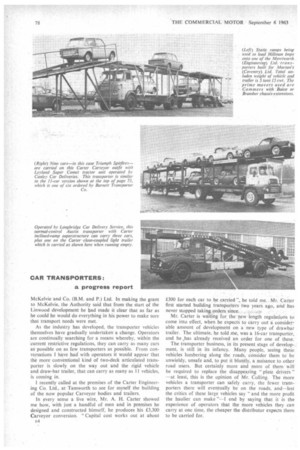McKelvie and Co. (B.M. and P.) Ltd. hi making the
Page 80

If you've noticed an error in this article please click here to report it so we can fix it.
grant to McKelvie, the Authority said that from the start of the Linwood development he bad made it clear that as far as he could he would do everything in his power to make sure that transport needs were met.
As the industry has developed, the transporter vehicles themselves have gradually undertaken a change. Operators are continually searching for a means whereby, within the current restrictive regulations, they can carry as many cars as possible on as few transporters as possible. From conversations I have had with operators it would appear that the more conventional kind of two-deck articulated transporter is slowly on the way out and the rigid vehicle and draw-bar trailer, that can carry as many as 11 vehicles, is coming in.
I recently called at the premises of the Carter Engineering Co. Ltd., at Tamworth to see for myself the building of the now popular Carveyor bodies and trailers.
In every sense a live wire, Mr. A. H. Carter showed me how, with just a handful of men and in premises he designed and constructed himself, he produces his £3,300 Carveyor conversion. "Capital cost works out at about E4 £300 for each car to be carried ", he told me. Mr. Carter first started building transporters two years ago, and has never stopped taking orders since. . , Mr. Carter is waiting for the new length regulations to come into effect, when he expects to carry out a considerable amount of development on a new type of drawbar trailer. The ultimate, he told me, was a 16-car transporter, and he has already received an order for one of these.
The transporter business, in its present stage of development, is still in its infancy. Many people, seeing these vehicles lumbering along the roads, consider them to be unwieldy, unsafe and, to put it bluntly, a nuisance to other road users. But certainly more and more of them will be required to replace the disappearing "plate drivers " —at least, this is the opinion of Mr. Coiling. The more vehicles a transporter can safely carry, the fewer transporters there will eventually be on the roads, and—lest the critics of these large vehicles say "and the more profit the haulier can make "—I end by saying that it is the experience of operators that the more vehicles they can carry at one time, the cheaper the distributor expects them to be carried for.
































































































































































































